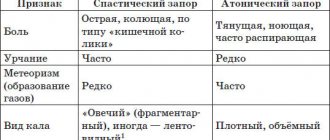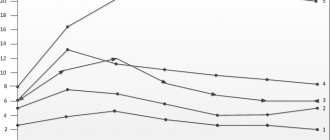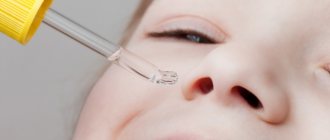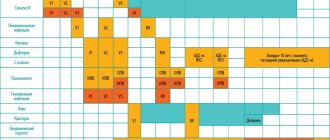General information
In order for a person to lead an active lifestyle, and for his body to function correctly, without failures, energy must flow into the cells, tissues of organs and systems. Its main source is glucose in the blood. To break it down and convert it into energy, it is necessary to have a certain hormone produced by the pancreas - insulin.
As a result of the development of any diseases of this organ, the production of the hormone decreases. The breakdown of glucose slows down. This leads to energy deficiency, which negatively affects the functioning of all human organs. At the same time, as food continues to enter the body, blood sugar levels rise, sometimes significantly exceeding normal levels. It settles in blood vessels in the form of single crystals. A person develops a dangerous, intractable disease – diabetes mellitus.
There are two types of diabetes:
- T1DM – consists of pancreatic dysfunction, insulin stops being produced completely or partially; energy does not flow to the cells;
- T2DM – characterized by cell insensitivity to insulin; Despite the fact that the gland continues to produce the hormone in sufficient quantities, the cells that have lost sensitivity do not absorb energy, and the sugar level in the blood increases.
Depending on what type of disease a person suffers from, a specific treatment method is prescribed. With T2DM, in some cases, following a special diet may be sufficient. If this method turns out to be ineffective, then over time the gland begins to produce less hormone. In this case, as with type 1 diabetes, insulin preparations are prescribed, which prevent the development of complications, expressed in disturbances in the functioning of internal organs (heart, kidneys), blood vessels, and decreased vision.
Drug concentration is also important
Insulins come in different concentrations: 40IU/ml - 40 units of insulin in 1 ml of solution; 100IU/ml - 100 units of insulin in 1 ml of solution; 300IU/ml - 300 units of insulin in 1 ml of solution. What does it mean? Let's say you need to inject 10 units of insulin. If you are using 40 IU/ml insulin, then a drop containing 10 units of the active substance will be much larger than that of insulin with a concentration of 300 IU/ml. Smaller drop means less risk of lipohypertrophy. Let us repeat: drugs cannot be tolerated when they are used thoughtlessly.
Proper use of insulin will allow you to lead an active, fulfilling life. With care, Your DiaMarka!
Insulin tablets
Despite this, many people with diabetes are afraid to start taking insulin. The main reason for this is the need for constant administration of the drug in the form of injections. The dream of many diabetics is insulin tablets. Despite the fact that you can sometimes find media reports that scientists from America and Australia were able to invent insulin tablets, this is most likely not true.
The dream of pills for type 1 diabetes is not yet possible. At the moment, this is the only method of treating T1DM that allows not only to improve the quality of life of a sick person, but also to significantly increase its duration. At the same time, it is not necessary to use a syringe to administer insulin, which is always difficult. Today, scientists, pharmacologists, and doctors suggest using such an invention as a syringe pen. The procedure with their help is simple, and the use of special needles for insulin syringe pens allows you to administer the drug absolutely painlessly.
Using the hormone to treat nervous disorders
The peculiarity of schizophrenia therapy is as follows:
- before breakfast, 4 units of the hormone are administered (Monday);
- every day the dose is increased by 1 unit (on Friday the figures are already 8 units);
- injections are not prescribed on weekends.
This is the first stage of treatment. The patient is brought to a state of hypoglycemia, in which he remains for several hours, then the indicators are restored with carbohydrate foods and a very sweet drink.
The second stage of therapy is accompanied by an increase in the amount of hormone administered. The patient is brought to a state of severe stupor, from which he is brought out after a quarter of an hour with the help of intravenous administration of glucose with insulin.
During a period of severe stupor, the patient may sleep, respond sluggishly to painful stimuli, or, conversely, mutter something tirelessly
The third stage is even more difficult. The dosage is increased to such an extent that the patient’s consciousness is on the border between severe stupor and coma (in common parlance they would say that an “overdose” has occurred). After half an hour, the patient is removed from the pathological state also with a dropper of glucose and insulin.
There should be at least 20 such sessions. Then the level of the administered drug is gradually reduced, completely eliminating it.
Classification of insulin
But even if the patient decides to take insulin injections, he will not be able to purchase the drug at the pharmacy on his own. It must be selected by an endocrinologist, especially since there are a lot of types of insulin on the shelves of modern pharmacies and it is very difficult to understand their purpose without special knowledge.
All insulin preparations are classified into types according to several criteria. For example, depending on the “origin”, the following types of insulin are distinguished.
- Obtained from the pancreas of pigs or cattle. The first option is preferable, since it is closer to the human one. In the second case, an allergic reaction may occur.
- Synthesized artificially using human rDNA insulin.
- Genetically engineered, it is also obtained from pork insulin using modern innovative technologies, which makes it possible to obtain a drug almost identical to the human hormone.
The following classification method takes into account the speed of penetration of the drug into the blood and the duration of its action. On this basis, insulin is divided into the following categories:
- ultra-short;
- short;
- average;
- long.
The drugs of the last two categories are considered basic, basic. They are administered 1-2 times a day, which allows you to maintain blood sugar levels at a normal level for a long period of time. Ultra-short and short preparations are used before each meal, which helps prevent the increase in blood sugar levels caused by the intake of food into the body.
Ultra-short
When used to lower blood sugar levels, it must be remembered that the faster the effect of the drug occurs, the shorter the duration of its action. The fastest, ultra-short drugs begin to work 10 minutes after administration. These are very powerful, effective medications, the effect of which is as close as possible to the natural hormone and lasts for 3 hours. The injection is given immediately before or immediately after a meal.
Short
The effect of the drug begins after 30 minutes and lasts for 5-8 hours. Preliminary administration of the medicine allows it to begin working simultaneously with the intake of food into the body, and it is desirable that it contains predominantly slow carbohydrates. A long period of action leads to the fact that the hormone remains in the blood after all the food has been absorbed and the amount of glucose in the blood has decreased. To prevent this from leading to hypoglycemia, additional food intake (snack) is necessary.
Like other insulin preparations, short- and ultra-short-acting drugs are introduced into the body using disposable syringes or reusable insulin pens into the subcutaneous fatty tissue. This promotes a more uniform, slow penetration of the hormone into the blood. The rate of absorption depends on various factors, primarily:
- injection site, it can be the shoulder, thigh, but the drug begins to act most quickly when it is injected into the stomach;
- the dose of the administered medication, the larger it is, the more effective the effect will be;
- the thickness of the fat layer, the smaller it is, the faster the absorption will be.
The drug and its dose are selected by a specialist endocrinologist, taking into account the characteristics of the patient’s body, depending on the stage of development of the disease. But a person with diabetes can independently regulate the dose, depending on the number of “bread units” entering the body: 1 unit of short-acting insulin is administered per 1 unit of bread, so that no more than 1 unit per kilogram of body weight enters the body at a time.
To accurately determine the dose, doctors recommend that patients keep a “food diary”. It is necessary to record each meal, the sugar level measured after that, the dose and name of the administered drug, and the concentration of glucose in the blood after taking the drug. This “Diary” allows the treating endocrinologist to choose a more effective treatment method. In addition, in the event of an emergency (the development of ketoacidosis), an emergency doctor or an intensive care unit specialist called to the house will also be able to use the notes taken to determine which medicine should be used to provide emergency care. In this case, the injection is given intravenously.
Medium and long
These drugs are intended for basic, basic therapy. They must be used daily, regardless of the time and amount of food taken. Medium-duration medications require administration twice a day: 2/3 of the dose in the morning before breakfast and 1/3 of the dose before dinner. With medium-lasting insulin, the effect is achieved after 1-1.5 hours, and the duration is 20 hours. Long-acting (long-term) insulin can be used once a day. It starts working in 1-3 hours. The main advantage of its use: the absence of a peak of activity. The concentration of insulin in the blood remains at a constant level throughout the entire duration of action, that is, 24 hours.
Depending on the type of diabetes mellitus, the stage of development of the disease, and the characteristics of the body, the doctor will prescribe one of two insulin therapy technologies.
- Combined. It is also called traditional and is used to treat patients who cannot take care of themselves or control the dose of the administered drug: elderly people, patients with diabetes with mental disorders, and so on. It involves the simultaneous administration of two drugs using one medical syringe, one of which is basic (medium-acting or long-acting), and the second is a short-acting drug. Its main disadvantage is its low efficiency, which leads to earlier manifestation of various complications.
- Basis-bolus therapy. In this case, both short and long-acting (medium) insulin preparations are also used. But unlike the traditional method, this option does not involve “mixing” them. They are administered in different injections, which makes it possible to bring their effect closer to the physiological production of the hormone by the body itself. This method is considered the best and is used more often.
How to prepare for the test
You need to take a test to determine your insulin level by following a number of rules. Otherwise, the results obtained will be unreliable. What you need to know about the analysis:
- Venous blood is used as a biomaterial;
- blood is taken on an empty stomach, provided that the last meal was no later than 10 hours before the start of the study;
- 5 days before the delivery of the biomaterial, it is necessary to exclude exhausting physical activity;
- at least 3 days before the test must be spent without drinking alcohol;
- if the patient is undergoing a course of drug treatment, the doctor must be warned about this, who, if necessary, will stop the therapy at the time of the study or postpone the tests until the course of treatment is completed;
- any stressful situations can affect the natural level of the hormone in the blood, so it is important to try to avoid conflicts and not worry a few hours before donating blood.
The result is usually ready the next day.
Release form
Insulin preparations go on sale in the form of solutions or suspensions, packaged in glass hermetically sealed bottles (5-10 ml). The top of the cork is rolled with an aluminum cap. For use in conjunction with a syringe pen, medicines are packaged in special cartridges (cases, cartridges).
For use in medical institutions, the drug can be in the form of a soluble white powder. It contains at least 3.1% sulfur. To introduce it into the body, it is diluted with special water for injection with the addition of hydrochloric acid, glycerin, and a solution of phenol (tricresol).
Filtration
The final push is cleaning. The liquid containing insulin is placed in a chromatograph. There they get rid of excess impurities and collect proteins together.
“The insulin is charged, and we take on another charge, and they attract each other. Everything that is not attracted goes away. We pour it out, well, relatively speaking, we dispose of it,” says Roman Dry, director of the research center.
The output is 99% insulin. Then it is crystallized, dried and turned into powder. Three tons of liquid turn into five kilograms of concentrate in 12 days. This is enough to provide injections to hundreds of thousands of people.
pharmachologic effect
Insulin drugs affect all tissues and internal organs of the human body. But its “work” is most pronounced in its effect on muscle and fat tissue, the liver, metabolic processes occurring in the body, and digestion. Among the main functions of these drugs:
- regulation of carbohydrate metabolism due to stimulation of glucose penetration through the cell membrane, which promotes its conversion into glycogen and further utilization;
- increased glycogen content in muscle tissue;
- stimulation of the formation of peptides, glucosyltransferase, hexokinase enzyme, pyruvate dehydrogenase multienzyme complex;
- suppression of fat breakdown (lipolysis), which leads to a reduction in the amount of free fatty acids and reduces their entry into the systemic circulation;
- reduces the formation of glucose from fatty acids and amino acids, prevents the breakdown of glycogen (glycogenolysis);
- prevents the synthesis of ketone (acetate) bodies;
- slows down the process of converting amino acids into oxocarboxylic acids and so on.
The effectiveness of the drug depends on the characteristics of the body, muscle activity, blood flow speed at the injection site, the administered drug and its dose. The effect of a substance can be different not only in different people, but also in the same person, depending on his condition.
Molecular Precision
A centrifuge helps separate the resulting “porridge” into ingredients.
“Under the influence of gravity, sedimentation occurs. Everything that is heavier settles, everything that is lighter rises. Accordingly, we understand that the inclusion bodies are heavier and are deposited. Therefore, we will use the sediment for further work with insulin,” says Roman Dry, director of the research center.
However, the protein in the rods initially folds incorrectly. To correct this, inclusion bodies are sent to a renaturation barrel. There, under the action of enzymes, the hormone takes the desired form.
“What happens to protein when we cook it? It's curling up! In principle, under laboratory conditions it can be unwrapped and turned back into a liquid. This is exactly what we are doing,” explains Sergei Salnikov, head of the insulin production workshop.
Afterwards the mass is concentrated again. But this is not insulin yet. Excess elements remain on proteins - C-peptides. They are cut off in a reactor, also under the action of enzymes.
Injection technique
Insulin can be administered independently, without assistance. To do this, you can use an insulin syringe or a special syringe pen. The latter method is more preferable, since it allows you to more accurately measure the required amount of substance. Another advantage is that the injection can be given directly through clothing, which is especially convenient for patients with diabetes who lead an active lifestyle: studying at a university, working in offices.
It is imperative to comply with all antiseptic requirements: wash your hands with soap, use only disposable syringes, treat the injection site with alcohol or alcohol-based antiseptic wipes. It should be remembered that alcohol destroys insulin, therefore, after treating the injection site, you must wait until the alcohol-containing liquid used for disinfection has completely dried, and only then inject. Do not inject the drug into the same place multiple times. Each time you need to retreat from the previous puncture by 2-3 centimeters. Changing the area of drug administration is done to prevent lipodystrophy.
Another method of administering insulin is called an insulin pump, which provides a continuous supply of the hormone. The system is a kind of syringe dispenser, consisting of the pump itself, a small computer designed to calculate the dose and control the drug administration regimen, a reservoir with the drug and a thin needle (cannula) for administering the drug.
This method of treatment is becoming increasingly widespread, since it allows one to take into account the amount of residual insulin in the blood and the amount of food entering the body. For administration using an insulin pump, ultra-short and short-acting drugs are used, but the number of skin punctures is minimized.
When using an insulin pump (doser), patients with diabetes have a more stable course of the disease, the quality of life increases, and the likelihood of complications decreases. At the same time, skeptics also note the negative aspects of using this method. First of all, this is an inconvenience, especially for those who want to lead an active lifestyle. In addition, a patient with diabetes is completely dependent on technology, because the process is completely automated. A malfunction of the program, failure of the device, or sudden loss of battery charge can lead to ketoacidosis. Another negative factor that is significant for many Russians is the high cost of the device.
Cocktail from sticks
To concentrate the resulting mass, it is driven through a separator. The volume is reduced to 500-600 liters.
Then the mixture is sent to a homogenizer. This device destroys sticks. The fact is that insulin accumulates inside them in small particles - inclusion bodies. To get the protein, you need to break the cell wall. To do this, in the homogenizer the pressure is first increased to 1000 atmospheres. Then they abruptly drop it. Bacteria cannot withstand changes and burst. Inclusion bodies mix with cell debris.
Insulin in bodybuilding
Some athletes and coaches believe that insulin drugs, especially short-acting ones, in combination with anabolic steroids and androgenic substances used in sports, will allow them to achieve better results. Indeed, regardless of whether the drug is administered to a sick or healthy person, its mechanism of action will be the same. In particular, the permeability of cell membranes in muscle tissue will increase. As a result, the process of penetration of steroids into cells will accelerate. Even if there is a small amount, the consequences can be more significant than without the use of insulin.
But athletes, like patients with diabetes, should carefully monitor compliance with the dosage and not forget about other, no less important rules:
- control the amount of nutrients entering the body, an excess of which will lead to their deposition as fat;
- reduce the amount of simple carbohydrates consumed;
- control not only the weight, but also the volume of the biceps, shins, and thighs.
The appearance of fatty deposits and folds indicates an incorrect calculation, the need to reduce the dose or completely stop introducing insulin drugs into the body.
Food for single-celled animals
For bacteria to multiply, they need a nutrient medium. It is produced in two tanks, they are called “kitchen” at the enterprise. The diet of unicellular organisms is balanced, and the quality of the future product depends on this. It takes no more than 12 hours to prepare.
“Our nutrient medium is plant-based. Was selected by our company. We developed it ourselves. These are mainly microelements and macroelements. And also plant extracts,” explains Sergei Salnikov, head of the insulin production workshop.
Almost all processes in the workshops are automated. People here only monitor instrument readings. Shift – several people. Most production facilities are behind glass. This ensures perfect cleanliness.
Single-celled organisms feed and reproduce in reactors with a volume of up to 2 tons. It is impossible to count the number of bacteria. There are several billion of them in just one milliliter of liquid.









